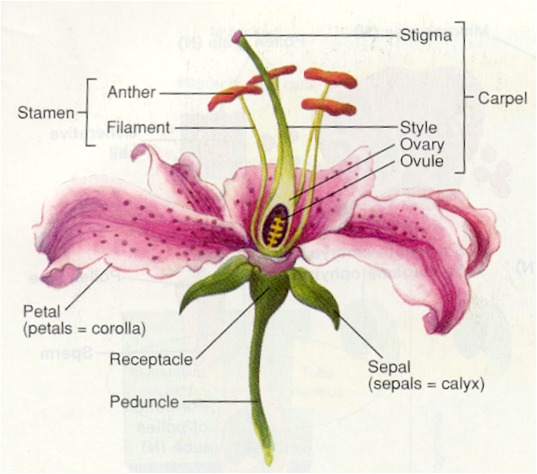Sexual Reproduction in plants
In flowering plants, a flower is the reproductive organ which is a specialised shoot consisting of modified stem and leaves.
Structure and Functions of parts of a flower

Receptacle
• expanded end of stalk which bears floral parts
Calyx
• consists of sepals
• usually green
• protect flower in bud
Corolla
• consist of petals
• often colored or scented to attract insects
Androecium
• male part of flower
• consist of stamens
• each stamen consists of an anther containing pollen sacs
• anther produces pollen grains which contain male gametes
Gynaecium
• female part of flower
• consists of one or more carpels
• each carpel contains one or more ovules in an ovary
• style bearing a stigma extends from ovary
• ovary contains female gametes which when fertilized become seeds
The meaning of the following terms which describe flowers
Hermaphrodite(Bisexual)
• One with both stamen and carpel eg Hibiscus
• Most flowers are hermaphrodite/bisexual
Unisexual
• Have only one of the reproductive organ: carpel or stamen i.e. either male or female flower.
Carpelate
• Also called pistilate
• contains only carpels hence a female flower
Staminate
• Also called a male flower.
• Contains stamens only.
Dioecious plants
• Have pistilate and staminate flowers on different plants e.g. pawpaw
The plants are also known as male or female plant.
Monoecius plants
• Have pistilate and staminate on one plant
• However, pistilate and staminate occur at different parts of the plants e.g. maize
Complete flower
• Has all four parts i.e. Calyx, corolla, androecium and gynoecium
Incomplete flower
• Do not have all four parts
• At least one part is missing.
Regular flower
Those that can be divided into two similar halves by any vertical section passing through the centre. this types of flowers are radially symmetrical.
Irregular flower
Can be divided into two equal halves in one particular plane only. such flowers are bilaterrally symmetrical.
Pedicillate flower
Flower with a stalk.
Solitary flower
Those that occur singly while those that grow in cluster make an inflorescence.
Types of ovary
Superior
• ovary occurs above other floral parts on the receptacle.

Inferior (epigynous)
• other floral parts arise above ovary on the receptacle.

Structure and Functions of parts of a flower

Receptacle
• expanded end of stalk which bears floral parts
Calyx
• consists of sepals
• usually green
• protect flower in bud
Corolla
• consist of petals
• often colored or scented to attract insects
Androecium
• male part of flower
• consist of stamens
• each stamen consists of an anther containing pollen sacs
• anther produces pollen grains which contain male gametes
Gynaecium
• female part of flower
• consists of one or more carpels
• each carpel contains one or more ovules in an ovary
• style bearing a stigma extends from ovary
• ovary contains female gametes which when fertilized become seeds
The meaning of the following terms which describe flowers
Hermaphrodite(Bisexual)
• One with both stamen and carpel eg Hibiscus
• Most flowers are hermaphrodite/bisexual
Unisexual
• Have only one of the reproductive organ: carpel or stamen i.e. either male or female flower.
Carpelate
• Also called pistilate
• contains only carpels hence a female flower
Staminate
• Also called a male flower.
• Contains stamens only.
Dioecious plants
• Have pistilate and staminate flowers on different plants e.g. pawpaw
The plants are also known as male or female plant.
Monoecius plants
• Have pistilate and staminate on one plant
• However, pistilate and staminate occur at different parts of the plants e.g. maize
Complete flower
• Has all four parts i.e. Calyx, corolla, androecium and gynoecium
Incomplete flower
• Do not have all four parts
• At least one part is missing.
Regular flower
Those that can be divided into two similar halves by any vertical section passing through the centre. this types of flowers are radially symmetrical.
Irregular flower
Can be divided into two equal halves in one particular plane only. such flowers are bilaterrally symmetrical.
Pedicillate flower
Flower with a stalk.
Solitary flower
Those that occur singly while those that grow in cluster make an inflorescence.
Types of ovary
Superior
• ovary occurs above other floral parts on the receptacle.

Inferior (epigynous)
• other floral parts arise above ovary on the receptacle.
